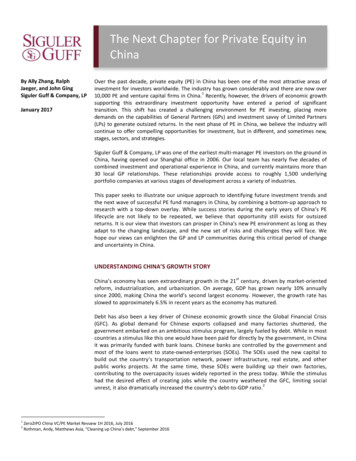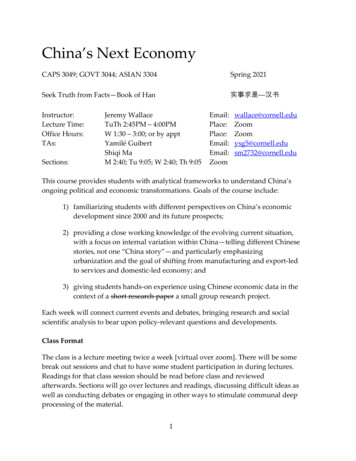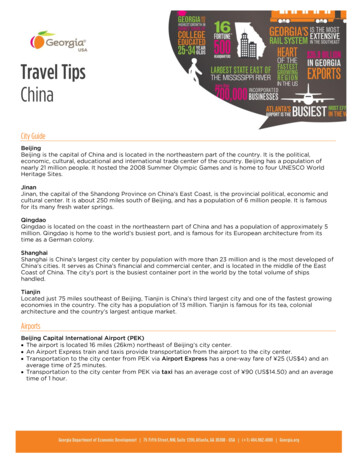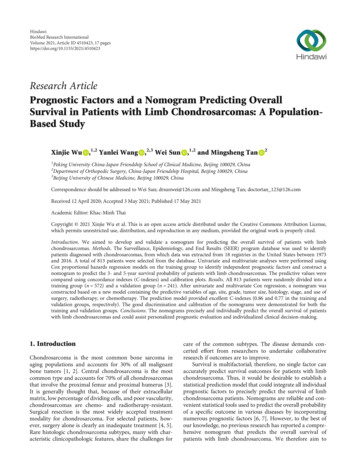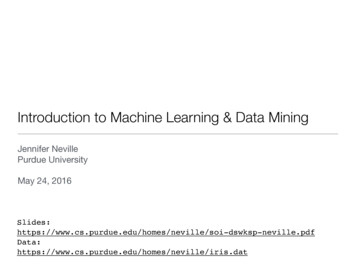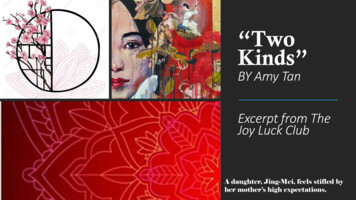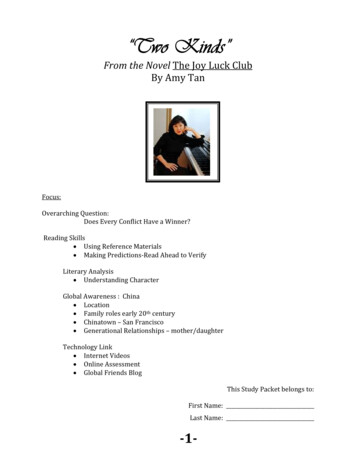
Transcription
“Two Kinds”From the Novel The Joy Luck ClubBy Amy TanFocus:Overarching Question:Does Every Conflict Have a Winner?Reading Skills Using Reference Materials Making Predictions‐Read Ahead to VerifyLiterary Analysis Understanding CharacterGlobal Awareness : China Location Family roles early 20th century Chinatown – San Francisco Generational Relationships – mother/daughterTechnology Link Internet Videos Online Assessment Global Friends BlogThis Study Packet belongs to:First Name:Last Name: 1
ConnectionsAbout the AuthorIf Amy Tan’s mother had gotten her way, Amy would have twoprofessions –doctor and concert pianist. Although Tan showed earlypromise in music, at thirty‐seven she became a successful fiction writerinstead. Tan’s first novel, The Joy Luck Club, drew on her troubledrelationship with her mother, who was born in China.Summary of “Two Kind” by Amy Tan [from the novel The Joy Luck Club]This story is about a conflict between a Chinese woman and her American‐borndaughter, Jing‐mei. The mother wants Jing‐mei to be famous. Jing‐mei refuses to dowhat her mother wants. This leads to an argument. Jing‐mei realizes that she wantsto follow her own pathBackground for the StoryIn 1949, the Communist Party seized control of China, following years of civil war.Like the mother in “Two Kinds,” a number of Chinese who feared Communists fledto the United States. Many of them lost everything except their hopes for a betterfuture. They placed these hopes on the shoulders of the children born in the newland. As you read, note how the daughter in “Two Kinds” deals with her mother’sexpectations.The ‘BIG Question’: Does every conflict have a winner?Parents and children have disagreements about. 2
Building BackgroundWhere in the World is China?Atlases and MapsReference materials provide many kinds of information. These references can help youfind facts and details: Atlases Almanacs Encyclopedias Internet resourcesAn atlas is a book containing maps of places in the world. Maps provideinformation about the geography, population, and economy of various places. Maps haveone or more of these features: legend or key – explains map symbols scale – shows the relationship between the size of a map and the actual sizeof the place that the map represents compass rose – shows directions [north, south, east, west]Reference MaterialsReference materials contain visual aids and text features that organizedetails and highlight important information. To locate information, followthese steps:1. Decide what type of information you need.2. Select a reference. Atlases, maps, and almanacs provide facts.Encyclopedias and Internet resources provide more details.3. Skim the reference. To skim a text, look through it quickly to learnwhat type of information it contains. Look at visual aids, such asphotographs, maps, and charts. read text features, such asheadings, subheadings, captions, and highlighted vocabulary.4. Look for keywords that relate to the information you need.Features in Atlases headings bold print map keys or legends captions for graphs 3
East Asia: China, Mongolia, and TaiwanChina is the world’s third‐largest country and its most populous—over one billionpeople live here. Under its communist government, which came to power in 1949, chinahas become a major industrial nation, but most o its people still live and work on the landas they have for thousands of years. Taiwan also has a booming economy and exports itsproducts around the world. Mongolia is a vast, remote country with a small population,many of whom are nomads.Most of China’s people live in the eastern part of the country, where climate,landscape and soils are most favorable. Urban areas there house more than 250 millionpeople, but almost 75% of the population lives in villages and farms the land. Taiwan’slowlands are very densely populated. In Mongolia, about 50% of the people live in thecountryside.Directions. Read the information and look at the maps on in your Pearson LiteratureOhio book, pages 73 – 74, to complete the below activities.Locate thisCountryChinaMongoliaOutline it inthis ColorRedBlackTaiwanUnited StatesGreenBlueIdentify thisCITYLocated in thisCOUNTRYShanghaiSan Francisco(California)TaipeiWooster (Ohio)ChinaUSA 4 TawainUSA
Directions. Fill in the chart below with 3‐5 facts/details about each of the Asian countriesyou read about.ChinaTaiwanMongoliaDirections. After watching the video about the importance of an education in rural China,answer the following questions.1. Summarize what you learned about the importance of education in China afterwatching the video.2. Give your reaction to what you saw in the video. What did you feel? 5
Family Roles in 20th Century ChinaRead the following about the role of the family in China during the early twentieth century.Then complete the chart about the roles of the family in China. [EXCERPT FROM The Pageantof Chinese History BY ELIZABETH SEEGER.]For in China, the family was even more important than it is in our country, and itwas very much larger. In our country, a family is usually made up of a father and motherand their children; perhaps one or two of their relatives may live with them, but usuallyeach family has its own house. In China, however, when a man grew up, he did not leavehis father’s house; he brought his wife home with him, and they lived with his parents inone big household. His brothers did the same thing, so that there were several familiesliving together in the one home. The houses were built around open courtyards, and nehouses and new courtyards could be added if they were needed, so that there was room foreveryone. No one left the home except the daughters when they married, for then theywent to their husbands’ homes and lived with their parents‐in‐law.The oldest man, usually the grandfather, was the head of the household; he wascalled the Elder, and no matter how old the sons and the grandsons were, they mustrespect and obey him, and they could do nothing important without his permission. Hiswife, the grandmother, had charge of all the housekeeping, and the unmarried daughtersand the sons’ wives must obey her and serve her. When the IElder died, his oldest son tookhis place, and the life of the household went on as before. Nothing belonged to any oneperson, for everything belonged to the family. All that the men raised in the fields orearned by their work was brought home and shared by everyone, and the women did thework of the house together.When anything important had to be done, the Elder called a family council, and theydecided together what they should do. The family arranged the marriages of the sons anddaughters, and decided what work the boys should be prepared for; if one of the sonswanted to go to another village or province and make his home there, he must ask theconsent of the Elder. This way of living bound them all very closely together, and gavethem a strong family feeling.When the old people died, food and clothing were put in their graves, for it wasbelieved that their spirits went right on living and would need those things. At certaintimes of the year, food and gifts were offered to them again, so that they would be happyand comfortable in the next world; and the family told them any important events that hadhappened—the birth of a child, a flood, a drought, a good harvest—just as if they had beenalive, and asked their blessing on all that was being done. for if their spirits still lived,would they not be deeply interested in all that went on at home?The household was a little community, where each one lived for the good of all. Itwas like a tiny state. That was why it was so important for a king, or for anyone else, to livehappily with his family. If he could be obedient and reverent to his parents, and live atpeace with his brothers and sisters, and love all his brothers’ children nearly as much as hisown; if he could live so well that there were no quarrels and no unhappiness in such a bighousehold, then, indeed he was fit to govern a province or a kingdom. 6
Use the chart below to record information about traditional Chinese beliefs and customsconcerning the relationship between parents and children.GrandfatherGrandmotherSonDaughterExplain what the family council is and its importance in Chinese culture: 7
Vocabulary Warm UpsWordPart ofSpeechDefinitionSentenceAssortmentNounCollection or varietySam chose a Twizzler from theassortment of candy.FascinatedVerbintently interested by somethingChris was fascinated by the novel.HeavingVerbRising and fallingAfter lifting the heavy table, her chestwas heaving.ImagesNounPictures, ideas, or likenesses ofsomething or someoneMany images came to mind when shethought about the holidays.MiniatureAdjectiveVery smallThe dollhouse contained miniaturefurniture.PetalsNounColored parts of a flower that areshaped like leavesThe rose petals were a pretty shade ofyellow.PurelyAdverbEntirelyWe met purely by accident.ProdigyNounA child of unusually high talentThe way she played the piano provedshe was a musical prodigy.There was lively conversationthroughout dinner.Throughout AdverbIn or during every part of; fromstart to finishApply what you know. Decide whether each statement below is true or false.1. Artists usually do not have many mental images when they paint.2. If you are breathing heavily, your chest may be heaving.3. If a library has a large assortment of books, it does not have much to read.4. Bored is the opposite of fascinated.5.An adult can sit comfortably on a miniature chair.6.If you leave a performance early, you will have stayed throughout it.7.If something happens purely by design, it was completely planned.8.Most flowers do not have colorful petals.9.Shirley Temple was an acting child prodigy of the 1930s. 8
ChinatownRead the following passage. Pay special attention to the bold words. Then read it again, andcomplete the activities.Read this column first:Chinatown, in San Francisco, is one of thelargest communities of Chinese Americansand Asian Americans in the United States.Chinese immigrants have been settlingthere since the 1850s. One of its famoussights is the Gateway to China. Built in the1970s, the gateway is known throughoutthe world as a symbol of San Francisco’sChinatown.Complete these Activities:1. The gateway is a symbol of Chinatownthroughout the world. What is another word forthroughout? Use throughout in a sentence:2. Underline the words that tell what assortment ofAs you walk along the streets ofthings bombard the senses.Chinatown, your senses are bombarded by What is an assortment?an assortment of smells, sounds, and sights.Flower markets catch the eye. The petals ofred, yellow, pink, and white flowers create adazzling splash of color.3. Underline the words that give clues to themeaning of the word petals. What is your favorite flower, and what color isits petals?4. Underline the words that tell what the strollersare fascinated by. Define fascinated:Strollers are fascinated by the manyobjects in souvenir shops. Miniaturestatues of animals, paper fans, umbrellas,jade jewelry, and silk dresses are just someof the shops’ treasures. Pieces of furniturepainted with dragons, butterflies, andflowers are purely imaginative works of art. 5. Circle the words that tell what kind of miniatureobjects are sold n the souvenir shops. Name some other miniature objects that aresold in stores:6. What is a synonym for purely? Use purely in a sentence: 9
Many of the buildings in San Francisco’sChinatown are banks or offices. They werebuilt to look like traditional Chinesebuildings, however. They bring to mindimages of Asian culture.7. Circle the words that tell what images arebrought to mind. Define images:Perhaps most important, visitors breathedeeply of the delicious smells that waft fromthe restaurants. If you enjoy spicy food, thisis the place to find it. If you do not like spicyfood, be careful. More than one diner hasexperienced a heaving chest after tasting abit of red pepper. There is mild food,however. At the end of the meal comes thefortune cookie. The little piece of rolled‐uppaper inside the cookie may contain aprediction about the future.8. What food may bring about a diner’sheaving chest? What does the word heaving mean?Chinatown is also known or its colorfulparades, with dancing dragons andfireworks, especially during the ChineseNew Year’s celebration. San Francisco’sChinatown is an intriguing neighborhoodwith a population, culture, and history all itsown. 10
While You ReadReading SkillsReading Ahead to Verify Predictions and re reading to look for detailsA prediction is an informed guess about what will happen. Use details in the textand your own knowledge and experience to make predictions as you read. Then, readahead to verify predictions, to check whether your predictions are correct.o As you read, ask yourself whether new details support your predictions. If theydo not, revise your predictions based on the new information.o If the predictions you make turn out to be wrong, re read to look for detailsyou might have missed that would have helped you make a more accurateprediction.“Of course you can be a prodigy, too,” my mother told me when I was nine.“You can be the best anything.”Details in the above passage can help you predict that he narrator’s mother willencourage her to become a prodigy. You can read further in the story “Two Kinds” to checkthis prediction.Directions: READ ‘TWO KINDS” BY AMY TAN and complete the following chart. If aprediction in the second column is correct, write correct in the third column. If aprediction is wrong, write incorrect in the third column. Then, in the fourth column,describe what does happen, and include a detail that would have allowed an accurateprediction. The first item has been completed as an example.Detail in“Two Kinds”Prediction1. The mother wantsher daughter to be a“Chinese ShirleyTemple.”2. The daughter beginsto think thoughts with“won’ts.”The daughter willbecome the ChineseShirley Temple.3. The narrator mustperform a simple piece“that sounded moredifficult than it was.”She will perform well.4. The daughter seesher mother’s offers ofthe piano “as a sign offorgivness.”The daughter will takethe piano.Verificationof PredictionIncorrectEvent in Selection andAdditional Detail The daughter will rebelagainst her mother. 11 The narrator fails at beingShirley Temple.“We didn’t immediately pickthe right kind of prodigy.”
After ReadingLiterary AnalysisCharactersA character is a person or an animal that takes part in the action of a literary work. A character’s motives are the emotions or goals that drive him or her to act oneway or another. Some powerful emotions are love, anger, and hope. Character traits are the individual qualities that make each character unique.These may be things such as stubbornness, sense of humor, or kindness.Characters’ motives and qualities are important because they influence what charactersdo and how they interact with other characters. When you read, think about what thecharacters are like and why they do what they do. For example, consider this passage:She had come here in 1949 after losing everything in China:her mother and father, her family home, her first husband,and two daughters, twin baby girls. But she never looked backwith regret. There were so many ways for things to get better.The above passage illustrates the mother’s character traits: her strength and courage. Italso suggests a motive for her actions: She wants things to get better.A. Directions: After each character’s name, write as many adjectives as you can think ofthat describe that character’s traits.1. The daughter:2. The mother: 12
B. Directions: Each quotation on the right states or hints at a motive for one of the actionson the left. On the line before each action, write the letter of the quotation that providesthe motive.ACTIONMOTIVE1. Daughter wants tobecome a prodigy.A. I could sense her anger rising to itsbreaking point. I anted to see it spillover.2. Mother pushes herdaughter to be aprodigy.B. I was filled with a sense that I wouldsoon become perfect. My motherand father would adore me.3. Daughter refuses to playthe piano.C. I saw the offer as a sign offorgiveness, a tremendous burdenremoved.4. Mother offers herdaughter the piano.D. I won’t let her change me, I promisedmyself. I won’t be what I am not.5. Daughter begins to resisther mother’s efforts tomake her a prodigy.E. “Only ask you be your best. For yoursake.”Directions. Complete the following questions. Be prepared to discuss your answers.1. Draw Conclusions: How does the difference in the attitudes of the mother anddaughter create problems?2. Make a Judgment: Should the narrator’s mother have pushed Jing‐mei as she did?Explain. 13
3. Literary Analysis: Using the chart below, identify Jing‐mei’s character traits. supportyour answers with details from the story.Jing‐mei’s Character TraitDetail from Story to Support4. Reading Skill: What prediction did you make about how the narrator would performat the piano recital? Explain why it was accurate or not. 14
Global FriendsDirection. Answer the following questions. Then put your answers on the Global Friends tablocated on our classroom blog [http://mrsdraudt.edublogs.org].Read the responses from our global friends all over the world.1. Do parents ever pressure their children to achieve? Why do you think so?2. What are some of the conflicts that parents and children have?3. Do you feel that people can be anything they want to be?4. Do all conflicts have winner?5. Put your answers on our classroom blog under the Global Friends Tab. 15
Academic IndicatorsThis unit of instruction will address the following Ohio Department of EducationAcademic Indicators for Seventh Grade:Acquisition of Vocabulary7.1. Define the meaning of unknown words through context clues and the author’s use ofcomparison, contrast, definition, restatement and example7.8. Determine the meanings and pronunciations of unknown words by using dictionaries,thesauruses, glossaries, technology and textual features, such as definitional footnotes or sidebarsReading Process: Concepts of Print, Comprehension Strategies and Self MonitoringStrategies7.1. Establish and adjust purposes for reading, including to find out, to understand, interpret, enjoyand solve problems7.2. Predict or hypothesize as appropriate from information in the text, substantiating with specificreferences to textual examples that may be in widely separated sections of text7.4. Summarize the information in texts, using key ideas, supporting details and referencing gaps orcontradictions.7.5. Select, create and use graphic organizers to interpret textual information7.6. Answer literal, inferential, evaluative and synthesizing questions to demonstratecomprehension of grade‐appropriate print texts and electronic and visual media7.7. Monitor own comprehension by adjusting speed to fit the purpose, or by skimming, scanning,reading on, looking back, note taking or summarizing what has been read so far in textReading Applications: Informational, Technical and Persuasive Text7.1. Use text features, such as chapter titles, headings and subheadings; parts of books includingindex, appendix, table of contents and online tools (search engines) to locate information7.5. Analyze information found in maps, charts, tables, graphs, diagrams, cutaways and overlaysReading Applications: Literary Text7.1. Explain interactions and conflicts (e.g., character vs. self, nature or society) between main andminor characters in literary text and how the interactions affect the plotResearch7.5. Analyze and organize important information, and select appropriate sources to support centralideas, concepts and themes 16
CitationsTextbook and Resource MaterialsSeeger, Elizabeth. The Pageant of Chinese History. Fourth Edition. New York City, NewYork: David McKay Company, Inc., 1962. 21‐22. Print.Tan,Amy. The Joy Luck Club. New Your City, New York: G.P.Putnam’s Sons, 1989. 132‐144.Print.Wiggins, Grant, Ph.D., et. al.Prentice Hall Literature – Ohio. 1st ed. Glenview, Illinois: Pearson Education, Inc.2010. 258‐ 277 and Unit 2 Resources. Print.ImagesAmy Tanachievement.orgAmy Tan at pianoachievement. orgCompass rose image:http://www.bing.com/images/search?q compass rose&FORM IGRE3#focal 141926619495f4dcbba2c041aa77ba71&furl tinvites%2f2005%2fCompass%2520Rose.jpgPiano .html 17
Lesson PlansThe purpose of this Unit is to expose students to Chinese culture and 21st centurytechnology skills within the framework of ODE English Language Arts indicators for 7thgrade. Students will 1. analyze and respond to literature elements2. read, comprehend, and analyze short stories reading skill: making predictions reading strategy: re‐read and read ahead comprehension.3. develop vocabulary4. gain global awareness and understanding of other cultures5. use technology to improve 21st skillsLesson One: Where in the World is China?1. Create a display of the following: The Joy Luck Club Book Several Atlases, almanacs, and encyclopedias Chinese cultural items as available World Map2. Pass out Student Study Packet and Pearson Literature Book to each student3. Read aloud Student Study Packet , page 2” About the Author Summary of “Two Kinds” Story Background Information4. Display of and describe reference materials: atlases, almanacs, encyclopedias5. Read aloud Student Study Packet, pages 3 – 4 and complete activities, using overhead ofmap and color code6. Read Literature Book pages 73‐74 & discuss7. Show video: China – rural schools [http://vimeo.com/groups/1354/videos/4556091]8. Complete chart and summary about what was learned on page 5 of Student StudyPacketMaterials needed: The Joy Luck Club novel Several Atlases, almanacs, encyclopedias Chinese cultural items as available for display World map for display “Two Kinds” Student Study Packet – one for each student Prentice Hall Literature – Ohio– one for each student Green, Blue, Black and Red colored pencils for each student Power Point: Family Roles in Twentieth Century China Infocus, overhead projector 18
Lesson Two: Traditional Family Roles in 20th Century China & San FranciscoChinatown in 1940s1. Read page 5‐6 in Student Study packet about family roles and complete chart, usingoverhead2. Show YouTube Videos on Chinatown [each about 3 minutes in length; located onclassroom blog] YouTube Video on TeaHouse in Chinatown:http://www.youtube.com/watch?v ZoaqMbyRse0&feature channel page YouTube Video showing streets with Chinese 19c6850c07fc4‐1512000652199 YouTube Video on Chinatown with Dragons/Street 85d765f80a96eb2a825‐1755596587127 YouTube Video on Chinatown with teenager narrating 9ee24d7bcfb9db2aec729ee24d7bcfb‐1746926044107 YouTube Video of vintage Chinatown and downtown San Francisco in1940s (black and white/shows cablecars and people 7956692299983. Review Vocabulary Words in “Two Kinds” Student Study Packet, page 7 and go overanswers4. Read aloud the passage “Chinatown” in Student Study Packet, page 85. Complete the reading activities about the passage “Chinatown”in“Two Kinds” Student Study Packet, pages 8‐9 discuss for understandingMaterials Needed Students need: “Two Kinds” Student Study Packet Prentice Hall Literature – Ohio book one for each student Infocus Computer with bookmarked YouTube VideosLesson Three: “Two Kinds”1. Complete While You Read information in “Two Kinds” Student Study Packet, page102. Read the story “Two Kinds” by Amy Tan, located on pages 260 – 276 of PrenticeHall Literature – Ohio book Each student completes the chart on page 9, using reading skills of readingahead to verify predictions and re‐reading to look for detail What is not done in class is homeworkMaterials Needed Students need: “Two Kinds” Student Study Packet 19
Student need: Prentice Hall Literature – Ohio bookLesson Four: Literary Analysis Understanding Generational Differences1. Go over the information in the prediction charts completed in Day Three located in“Two Kinds” Student Study Packet, page 10.2. Complete the After Reading activities re: Literary Analysis – Character located in“Two Kinds” Student Study Packet, pages 11 – 13, and discuss for understanding.3. Global Friends Students & our Global Friends will blog on our classroom website to the prompts:o Do parents ever pressure their children to achieve? Why do you think so?o What are some of the conflict that parents and children have?o Do you feel that people can be anything they want to be?o Do all conflicts have winners? Global Friends is a section of classroom blogMaterials Needed Students need: “Two Kinds” Student Study Packet Prentice Hall Literature – Ohio book one for each student Put prompts on Global Friends tab on classroom blog:http://mrsdraudt@edublogs.orgLesson Five: AssessmentAssess students’ comprehension and mastery of the skills by having them answerquestions re: critical thinking, reading skills, literary analysis, and vocabulary using onlineassessment tool http://www.quia.com/profiles/draudt link found on classroom blog: http://mrsdraudt@edublogs.orgMaterials Needed Computer for each student teacher created assessment put on Quia site and linked to classroom blog 20
instead. Tan’s first novel, The Joy Luck Club, drew on her troubled relationship with her mother, who was born in China. Summary of “Two Kind” by Amy Tan [from the novel The Joy Luck Club] This st

